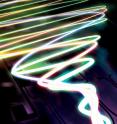Manipulating light on a chip for quantum technologies
A team of physicists and engineers at Bristol University has demonstrated exquisite control of single particles of light — photons — on a silicon chip to make a major advance towards long-sought-after quantum technologies, including super-powerful quantum computers and ultra-precise measurements. The Bristol Centre for Quantum Photonics has demonstrated precise control of four photons using a microscopic metal electrode lithographically patterned onto a silicon chip.
The photons propagate in silica waveguides — much like in optical fibres — patterned on a silicon chip, and are manipulated with the electrode, resulting in a high-performance miniaturized device.
"We have been able to generate and manipulate entangled states of photons on a silicon chip" said PhD student Jonathan Matthews, who together with Alberto Politi performed the experiments. "These entangled states are responsible for famously 'weird' behaviour arising in quantum mechanics, but are also at the heart of powerful quantum technologies."
"This precise manipulation is a very exciting development for fundamental science as well as for future quantum technologies." said Professor Jeremy O'Brien, Director of the Centre for Quantum Photonics, who led the research.
The team reports its results in the latest issue of Nature Photonics [June 2009], a sister journal of the leading science journal Nature, and in a Postdeadline Paper at The International Quantum Electronics Conference (IQEC) on June 4 in Baltimore, USA [IQEC Postdeadline Papers].
Quantum technologies with photons
Quantum technologies aim to exploit the unique properties of quantum mechanics, the physics theory that explains how the world works at microscopic scales.
For example a quantum computer relies on the fact that quantum particles, such as photons, can exist in a "superposition" of two states at the same time — in stark contrast to the transistors in a PC which can only be in the state "0" or "1".
Photons are an excellent choice for quantum technologies because they are relatively noise-free; information can be moved around at the speed of light; and manipulating single photons is easy.
Making two photons "talk" to each other to generate the all-important entangled states is much harder, but Professor O'Brien and his colleagues at the University of Queensland demonstrated this in a quantum logic gate back in 2003 [Nature 426, 264 (2003)].
Last year, the Centre for Quantum Photonics at Bristol showed how such interactions between photons could be realised on a silicon chip, pointing the way to advanced quantum technologies based on photons [Science 320, 646 (2008)].
Photons are also required to "talk" to each other to realise the ultra-precise measurements that harness the laws of quantum mechanics. In 2007 Professor O'Brien and his Japanese collaborators reported such a quantum metrology measurement with four photons [Science 316, 726 (2007)].
Manipulating photons on a silicon chip
"Despite these impressive advances, the ability to manipulate photons on a chip has been missing," said Mr Politi. "For the last several years the Centre for Quantum Photonics has been working towards building fully functional quantum circuits on a chip to solve these problems," added Prof O'Brien.
The team coupled photons into and out of the chip, fabricated at CIP Technologies, using optical fibres. Application of a voltage across the metal electrode changed the temperature of the silica waveguide directly beneath it, thereby changing the path that the photons travelled. By measuring the output of the device they confirmed high-performance manipulation of photons in the chip.
The researchers proved that one of the strangest phenomena of the quantum world, namely "quantum entanglement", was achieved on-chip with up to four photons. Quantum entanglement of two particles means that the state of either of the particles is not defined, but only their collective state, and results in an instantaneous linking of the particles.
This on-chip entanglement has important applications in quantum metrology and the team demonstrated an ultra-precise measurement in this way.
"As well as quantum computing and quantum metrology, on-chip photonic quantum circuits could have important applications in quantum communication, since they can be easily integrated with optical fibres to send photons between remote locations," said Alberto Politi.
"The really exciting thing about this result is that it will enable the development of reconfigurable and adaptive quantum circuits for photons. This opens up all kinds of possibilities," said Prof O'Brien.
A commentary on the work that appeared in the same issue [Nature Photonics 3, 317 (2009)] described it as "an important step in the quest for quantum computation" and concluded: "The most exciting thing about this work is its potential for scalability. The small size of the [device] means that far greater complexity is possible than with large-scale optics."
Source: University of Bristol
Other sources
- Manipulating Light On A Chip For Quantum Technologiesfrom Science DailyMon, 8 Jun 2009, 15:35:39 UTC
- Manipulating light on a chip for quantum technologiesfrom PhysorgFri, 5 Jun 2009, 17:49:06 UTC
- Scientists Demonstrate All-fiber Quantum Logicfrom Science DailyThu, 4 Jun 2009, 2:28:31 UTC
- Ultra cold atoms help share quantum informationfrom Physics WorldTue, 2 Jun 2009, 23:42:14 UTC
